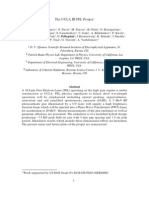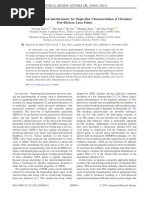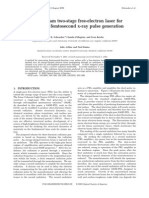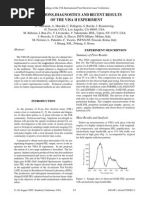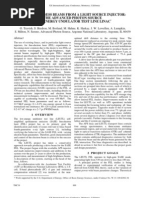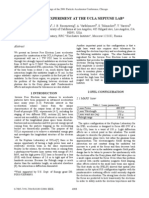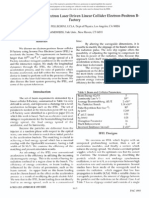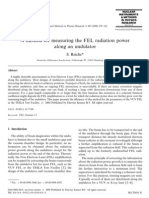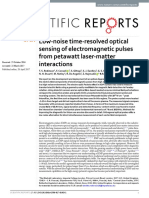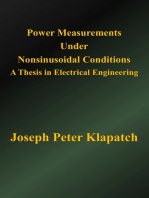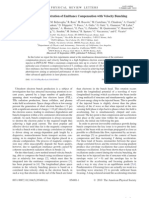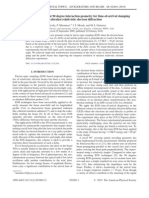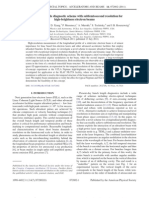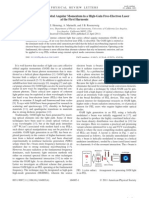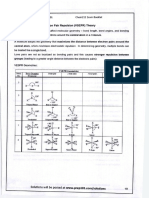0 ratings0% found this document useful (0 votes)
26 viewsHogan 1995 0225
Hogan 1995 0225
Uploaded by
Particle Beam Physics LabThe document summarizes the status of the UCLA high-gain infrared free electron laser. It describes the electron beamline that produces a 17 MeV electron beam and the 60 cm long undulator. Simulations predict that the FEL will produce infrared radiation in the 10-20 micron range from self-amplified spontaneous emission. Key diagnostics to characterize shot-to-shot beam properties and microbunching include beam position monitors, screens, emittance slits, and a coherent transition radiation monitor. Simulations indicate the FEL output power will fluctuate by +40%/-25% for 10% beam current variations and will be sensitive to beam size, energy spread, and emittance. Experiments will study startup from
Copyright:
Attribution Non-Commercial (BY-NC)
Available Formats
Download as PDF, TXT or read online from Scribd
Hogan 1995 0225
Hogan 1995 0225
Uploaded by
Particle Beam Physics Lab0 ratings0% found this document useful (0 votes)
26 views3 pagesThe document summarizes the status of the UCLA high-gain infrared free electron laser. It describes the electron beamline that produces a 17 MeV electron beam and the 60 cm long undulator. Simulations predict that the FEL will produce infrared radiation in the 10-20 micron range from self-amplified spontaneous emission. Key diagnostics to characterize shot-to-shot beam properties and microbunching include beam position monitors, screens, emittance slits, and a coherent transition radiation monitor. Simulations indicate the FEL output power will fluctuate by +40%/-25% for 10% beam current variations and will be sensitive to beam size, energy spread, and emittance. Experiments will study startup from
Original Title
hogan 1995 0225
Copyright
© Attribution Non-Commercial (BY-NC)
Available Formats
PDF, TXT or read online from Scribd
Share this document
Did you find this document useful?
Is this content inappropriate?
The document summarizes the status of the UCLA high-gain infrared free electron laser. It describes the electron beamline that produces a 17 MeV electron beam and the 60 cm long undulator. Simulations predict that the FEL will produce infrared radiation in the 10-20 micron range from self-amplified spontaneous emission. Key diagnostics to characterize shot-to-shot beam properties and microbunching include beam position monitors, screens, emittance slits, and a coherent transition radiation monitor. Simulations indicate the FEL output power will fluctuate by +40%/-25% for 10% beam current variations and will be sensitive to beam size, energy spread, and emittance. Experiments will study startup from
Copyright:
Attribution Non-Commercial (BY-NC)
Available Formats
Download as PDF, TXT or read online from Scribd
Download as pdf or txt
0 ratings0% found this document useful (0 votes)
26 views3 pagesHogan 1995 0225
Hogan 1995 0225
Uploaded by
Particle Beam Physics LabThe document summarizes the status of the UCLA high-gain infrared free electron laser. It describes the electron beamline that produces a 17 MeV electron beam and the 60 cm long undulator. Simulations predict that the FEL will produce infrared radiation in the 10-20 micron range from self-amplified spontaneous emission. Key diagnostics to characterize shot-to-shot beam properties and microbunching include beam position monitors, screens, emittance slits, and a coherent transition radiation monitor. Simulations indicate the FEL output power will fluctuate by +40%/-25% for 10% beam current variations and will be sensitive to beam size, energy spread, and emittance. Experiments will study startup from
Copyright:
Attribution Non-Commercial (BY-NC)
Available Formats
Download as PDF, TXT or read online from Scribd
Download as pdf or txt
You are on page 1of 3
STATUS OF THE UCLA HIGH-GAIN
INFRARED FREE ELECTRON LASER *
M. Hogan, C. Pellegrini, J. Rosenzweig, G. Travish
UCLA Department of Physics, Los Angeles, CA 90024, USA
A.Varfolomeev
Kurchatov Institute, Moscow, Russia
A compact, infrared (10-20 µm), high-gain FEL is being
commissioned at the Particle Beam Physics Laboratory II. OVERVIEW
(PBPL) at UCLA. A 60 cm long undulator with a period of
1.5 cm and an undulator parameter K≈1 has been built to be
used in conjunction with the PBPL beam. Experiments will a. The Beamline
focus on FEL physics pertinent to proposed short wavelength
The beam is produced in an S-band RF copper
devices. Of particular interest is exploration of startup from
photocathode gun driven by a frequency-quadrupled, pulse-
noise, self amplified spontaneous emission (SASE), beam
compressed Nd:YAG laser (UV) [2]. Solenoids control the
parameter effects on gain, and output power fluctuations.
highly divergent beam and provide for emittance compensation
Beam micro-bunching due to the FEL action will also be
[3] into the linac. A Plane Wave Transformer linac (PWT)
measured using coherent transition radiation. Here we present
accelerates the electrons from an injection energy ~4 MeV to a
an overview of the relevant diagnostics, FEL simulation
final energy of ~17 MeV [4].
results and proposed experiments.
Six of the quadrupoles are used to match the four phase-
space parameters needed for injection into the undulator. The
I. INTRODUCTION magnetic center of the beamline is passively aligned to
~100µm using machined brackets, optical tables, and linear
The Free Electron Laser has shown potential as a light bearings (rails). This tolerance was chosen based on the
source in the infrared, UV and, as recent proposals indicate, in performance simulations of our FEL. A second dipole after the
the XUV and X-ray regime. While oscillator experiments have undulator will bend the electron beam away from the optical
provided a number of verifications and enhancements to theory pulse to facilitate the IR optics/diagnostics.
and operational experience, few high-gain amplifier systems
have operated in the optical regime. This paper describes the b. Diagnostics
UCLA IR FEL – a system designed to study critical issues in An unsaturated high-gain FEL is highly (exponentially)
high-gain systems and to improve the operational FEL and sensitive to certain beam-parameter fluctuations. Thus, beam
accelerator experience with the requisite high-brightness diagnostics on the UCLA system are designed for single-bunch
beams. (shot-to-shot) operation. Beam position, size, charge and
The UCLA experiment was designed to study issues emittance are measured using the following:
important to future short wavelength devices at a minimum of • Stripline beam position monitors (BPMs) for non-
cost and space. The short-period undulator, combined with our destructive measurements.
moderate-energy beam produces radiation in the infrared (IR), • Phosphor screens and video cameras.
where a large number of diagnostics are available, without the • Integrating Current Transformer (ICT).
added complexity of producing a higher-energy beam necessary • Slits (1D pepper pots) to measure the effective
for operation at shorter wavelengths. Further, working in the transverse emittance of the space-charge dominated
IR does not suffer from the beam noise problems associated beam [5].
with past microwave FELs. The lack of suitable sources at • A SLAC-like pulse-length monitor to make non-
short wavelengths makes the feasibility of start up from noise destructive shot-to-shot pulse-length measurements
(SASE) important [1]. Additionally, the difficulty of [6].
producing high reflectance mirrors makes an oscillator The first dipole magnet, in conjunction with the
configuration impractical for short wavelengths, so successful quadrupoles, is used as a spectrometer to measure the energy
operation in the high-gain regime is a necessary precursor to and the energy spread. The second dipole will also allow for a
designing short-wavelength devices. For these reasons the FEL crude energy measurement after the beam exits the undulator.
studies will begin from SASE in the high gain regime. Other diagnostics include Faraday Cups for charge
*Work supported by US DOE Grants DE-FG03-90ER40796 and DE-FG03-92ER40693.
measurement and Cherenkov radiators, in conjunction with a
streak camera, to measure the absolute pulse length. III. SIMULATION PREDICTIONS
c. Microbunching monitor The lack of experimental work on SASE optical FELs
Coherent transition radiation (CTR) can be used to necessitates relying on numerical simulations to predict the
measure the extent of bunching in the FEL. We plan on performance of our experiment. Earlier work in the IR on the
installing a foil at the exit of the undulator to study the Paladin FEL at LLNL has helped test high gain codes, but has
bunching. Calculations indicate that the expected 5% bunching not provided information on startup from noise [10].
factor should produce CTR in the FEL band comparable to the Fluctuations in FEL performance, especially from startup, and
FEL output itself [7]. sensitivities to system parameters are a critical issue in future
short-wavelength high-gain systems where output stability and
d. The Undulator saturation are significant to users. Simulations of the UCLA
A planar undulator 60 cm long with a 1.5 cm period, 5 system have been performed to investigate such sensitivities
mm fixed gap spacing and a greater than 7 kG peak field in hopes of performing experimental comparisons. Most of
awaits installation into the beamline. The undulator was the following work was performed with TDA3D [11] and
designed to provide IR radiation from modest beam energies (< includes 3D effects, diffraction, emittance and energy spread.
20 MeV) while maintaining a strong coupling (K~1). An rms
field uniformity of better than 0.18%, measured using both a a. Current
Hall probe and the pulsed wire technique [8], should assure The beam current is our easiest parameter to control and
good FEL performance. Additionally, the second integral of measure. Spontaneous emission can be differentiated from
the undulator field satisfies the requirement that the rms amplified (stimulated) radiation by observing the dependence
electron beam deflection in the wiggle plane (~105 µm) be on current: spontaneous emission is broadband and scales
less than the rms beam waist (~200 µm). It should be notes linearly with the current, while amplified radiation power, P,
that the construction of the FEL is not well suited to studying scales as P~Iexp(αI^4/3) where α is a constant and I is the
the effects of varying undulator parameters such as field beam current.
strength and error. Simulations of gain vs. current show that current
variations ~ 10% vary the FEL output power +40%/-25%.
Table 1: Electron Beam and FEL Parameters expected for the Current variations of this order are within our ability to
UCLA IRFEL. measure, and power (energy) fluctuations of a few percent are
within our detector / electronics bandwidth. The challenge will
Electron Beam Parameters [Expected]
lie in deconvolving a variation of beam current from
Energy 17 MeV
parameters such as beam size, pulse length, energy spread and
Energy Spread (uncorr.) 0.1%
emittance.
Current (peak) 200 Amps
Pulse Length (rms) ~5 psec b. Beam Size
Norm. Emittance (rms) 5 mm mrad Beam-size changes, such as those caused by space charge,
Undulator Parameters [Measured] affect the beam density as well as the matching into the
Total length 60 cm undulator. The FEL is sensitive to the overall (six
Undulator period 1.5 cm dimensional) beam density, however small changes in the
Peak field on axis 7.3 kG transverse beam size should cause predictable changes in the
Pole face gap (fixed) 5 mm FEL performance. Further, simulations predict FEL
Undulator parameter (K) ~1 performance is insensitive to achievable beam matching.
FEL parameter (ρ) [9] ~1 x 10-2 Regardless, matching is a technical issue that needs to be
FEL Parameters [Simulations @10.6 µm] resolved with experience in beam handling. Phosphor screens
Radiation wavelength 10-20 µm and BPMs should provide sufficient operator feedback on beam
size.
Power gain length 7.2 cm
SASE peak power 3 mW @ 7.2cm
c. Pulse Length
~1 W @ 60cm
Only a few “finite pulse” simulations have been
performed on our system. Slippage is a factor in the
performance of this system; however, over the short undulator
being initially used the output power is not degraded severely. response time of the detector. By removing the Winston Cone
Further work is needed to quantify (through simulations and and aperturing the field of view of the detector to limit the
experiment) this effect. collected background, the SNR can be increased by several
The pulse length is also a factor in much the same way additional orders of magnitude. Other detectors such as
that beam size is. The variation of the pulse length due to Mercury-Cadmium-Telluride photodiodes may offer the
laser fluctuations and space charge are still an experimental advantage of faster response times and/or higher quantum
uncertainty. efficiencies, while only needing to be cooled to liquid Nitrogen
temperature. Both the spontaneous emission and the amplified
d. Energy Spread signal should be well within our sensitivity, and studies of
Wakefields (primarily from the linac) are expected to SASE FEL radiation production should be feasible.
produce a correlated energy spread ~ 1%. This spread can be
ameliorated by running the linac “off crest”. Any residual V. ACKNOWLEDGMENTS
correlated energy spread will give rise to a broader radiation
bandwidth. Our IR detectors are broadband and nearly linear The authors thank Dick Cooper for the hyphens. We also
over such linewidths, so that integrating over the wavelengths thank I. B. Shankin for many useless discussions and Noah
is inherent in the instrumentation. The expected uncorrelated Arref and R. Uin, et al. without whom this experiment would
energy spread (PARMELA [12] simulated and initially be possible.
measured) of <0.5% does not substantially degrade FEL
performance.
VI. REFERENCES
e. Emittance
[1] H. Winick, et al., Proceedings of the 8th SRI93,
The only single-shot emittance measurements available to Gaithersburg, MD, August 23-26, 1993.
us are destructive slits. Hence, we will not be able to measure [2] J. Rosenzweig, et al., Nucl. Instr. and Meth. A 341 (1994)
emittance “on line” with the FEL operating, but by knowing 379-385.
all the other beam parameters it may be possible to calibrate [3] B.E. Carlsten, Nucl. Instr. and Meth. A 285 (1989) 313.
the emittance. Simulations indicate that an emittance much [4] R. Zhang, et al., Proc. this conference.
poorer than the design value can still yield measurable gain. [5] J. Rosenzweig and G. Travish, UCLA Dept. of Physics –
CAA–TECH–NOTE #64
IV. DETECTION OF SASE [6] E. Babenko, et al., SLAC-PUB-6203 (JUNE 1993).
[7] J. Rosenzweig, G. Travish and A. Tremaine, Submitted to
The low-level SASE signal (see Table 1.), which can be Nuc. Inst. and Meth. A.
calculated from numerical integration or simple 1-D theory [8] G. Travish, UCLA Dept. of Physics, CAA–TECH–NOTE
[13], requires the use of cryogenic detectors to obtain the #34.
necessary sensitivity. A non-imaging optic (Winston Cone) [9] R. Bonifacio, C. Pellegrini and L. M. Narducci, Opt.
will maximize collection efficiency during initial operation, Commun. 50, p373 (1984).
but may degrade the signal-to-noise ratio (SNR) by collecting [10] J. T. Weir, et al., Proc. SPIE vol.1133:97-101 (1989).
large amounts of background. Background (blackbody) [11] T. M. Tran and J.S. Wurtele, Computer Phys. Commun.
radiation constitutes a DC offset/pedestal that may be 54 pp. 263-272 (1989) and T. M. Tran and J.S. Wurtele,
compensated for up to the level of the shot noise. Physics Reports 195 pp. 1-21 (1990).
Commercially available IR detectors have relatively long time [12] K. R. Crandall and L. Young, Computer Codes for
constants (~nsec) with respect to the pulse (~psec), so that the Particle Accelerator Design and Analysis, LA-UR-90-
integrated background noise may be significant. An available 1766, Los Alamos (1990).
copper-doped germanium detector should provide a SNR of [13] K. J. Kim, Physical Review Letters 57(13), pp. 1871-
~103, neglecting signal loss in the optics, pre-amplifier noise, 1874 (1986).
and reduction in detectivity due to operating far below the
You might also like
- Field Guide To PolarizationDocument143 pagesField Guide To PolarizationChang Ming100% (1)
- Cheat Sheet For MaterialDocument2 pagesCheat Sheet For Materialhajerah sulaimanNo ratings yet
- Microscope ActivityDocument5 pagesMicroscope ActivityJulie GerberNo ratings yet
- Parametric Study of An X-Ray FELDocument5 pagesParametric Study of An X-Ray FELParticle Beam Physics LabNo ratings yet
- Pellegrini 1996 0397Document7 pagesPellegrini 1996 0397Particle Beam Physics LabNo ratings yet
- Dodd 1991 0002Document3 pagesDodd 1991 0002Particle Beam Physics LabNo ratings yet
- Andonian 2005 643Document4 pagesAndonian 2005 643Particle Beam Physics LabNo ratings yet
- Rosenzweig 1993 0242Document7 pagesRosenzweig 1993 0242Particle Beam Physics LabNo ratings yet
- Pellegrini 1993 0352Document5 pagesPellegrini 1993 0352Particle Beam Physics LabNo ratings yet
- Saturnus: The UCLA High-Gain Infrared FEL ProjectDocument4 pagesSaturnus: The UCLA High-Gain Infrared FEL ProjectParticle Beam Physics LabNo ratings yet
- Schroeder 2001 0123Document3 pagesSchroeder 2001 0123Particle Beam Physics LabNo ratings yet
- Hogan 1996 0204Document4 pagesHogan 1996 0204Particle Beam Physics LabNo ratings yet
- Status and Initial Commissioning of A High Gain 800 NM Sase FelDocument4 pagesStatus and Initial Commissioning of A High Gain 800 NM Sase FelParticle Beam Physics LabNo ratings yet
- Zhang 1993 0246Document5 pagesZhang 1993 0246Particle Beam Physics LabNo ratings yet
- Status of The Ucla Pegasus LaboratoryDocument2 pagesStatus of The Ucla Pegasus LaboratoryParticle Beam Physics LabNo ratings yet
- PhysRevLett 131 205002Document6 pagesPhysRevLett 131 205002xuanyuanleiwzNo ratings yet
- Chirped-Beam Two-Stage Free-Electron Laser For High-Power Femtosecond X-Ray Pulse GenerationDocument8 pagesChirped-Beam Two-Stage Free-Electron Laser For High-Power Femtosecond X-Ray Pulse GenerationParticle Beam Physics LabNo ratings yet
- H Igh Energy Gain Ifel at Ucla Neptune LaboratoryDocument5 pagesH Igh Energy Gain Ifel at Ucla Neptune LaboratoryParticle Beam Physics LabNo ratings yet
- Slac Pub 11379Document4 pagesSlac Pub 11379Particle Beam Physics LabNo ratings yet
- Parametric Study of An X-Ray FELDocument4 pagesParametric Study of An X-Ray FELParticle Beam Physics LabNo ratings yet
- Simulations, D: Iagnostics and Recent Results of The Visa Ii ExperimentDocument4 pagesSimulations, D: Iagnostics and Recent Results of The Visa Ii ExperimentParticle Beam Physics LabNo ratings yet
- Travish 2000 0563Document3 pagesTravish 2000 0563Particle Beam Physics LabNo ratings yet
- Andonian 2005 639Document3 pagesAndonian 2005 639Michael Fairchild100% (2)
- Muller 2003 0547Document2 pagesMuller 2003 0547Particle Beam Physics LabNo ratings yet
- Diagnostics Aug 1999Document2 pagesDiagnostics Aug 1999Particle Beam Physics LabNo ratings yet
- On The Ifel Experiment at The Ucla Neptune Lab : Proceedings of The 2001 Particle Accelerator Conference, ChicagoDocument3 pagesOn The Ifel Experiment at The Ucla Neptune Lab : Proceedings of The 2001 Particle Accelerator Conference, ChicagoParticle Beam Physics LabNo ratings yet
- Lampel 1995 0223Document3 pagesLampel 1995 0223Particle Beam Physics LabNo ratings yet
- High Energy Gain of Trapped Electrons in A Tapered, Diffraction-Dominated Inverse-Free-Electron LaserDocument10 pagesHigh Energy Gain of Trapped Electrons in A Tapered, Diffraction-Dominated Inverse-Free-Electron LaserParticle Beam Physics LabNo ratings yet
- Rosenzweig 1991 0286Document3 pagesRosenzweig 1991 0286Particle Beam Physics LabNo ratings yet
- Results Ofthe VISA SASE FEL Experiment at 840 NM: Article in PressDocument5 pagesResults Ofthe VISA SASE FEL Experiment at 840 NM: Article in PressParticle Beam Physics LabNo ratings yet
- FEL Parameters and Performance: Echnical YnopsisDocument30 pagesFEL Parameters and Performance: Echnical Ynopsisuser_14No ratings yet
- Reiche 2001 0106Document3 pagesReiche 2001 0106Particle Beam Physics LabNo ratings yet
- Acceleration of Electrons in A Diffraction Dominated Ifel: Experimental SetupDocument4 pagesAcceleration of Electrons in A Diffraction Dominated Ifel: Experimental SetupParticle Beam Physics LabNo ratings yet
- Nelis 2007Document5 pagesNelis 2007johnpaulcallejo1No ratings yet
- Reiche 2001 0110Document5 pagesReiche 2001 0110Particle Beam Physics LabNo ratings yet
- The Ucla Helical Permanent-Magnet Inverse Free Electron LaserDocument3 pagesThe Ucla Helical Permanent-Magnet Inverse Free Electron LaserParticle Beam Physics LabNo ratings yet
- Murphy 1984 0069Document9 pagesMurphy 1984 0069Particle Beam Physics LabNo ratings yet
- High Energy Gain of Trapped Electrons in A Tapered, Diffraction-Dominated Inverse-Free-Electron LaserDocument4 pagesHigh Energy Gain of Trapped Electrons in A Tapered, Diffraction-Dominated Inverse-Free-Electron LaserParticle Beam Physics LabNo ratings yet
- Barov 1993 0253Document3 pagesBarov 1993 0253Particle Beam Physics LabNo ratings yet
- Supermode Noise Suppression of The Harmonically Mode-Locked FiberDocument15 pagesSupermode Noise Suppression of The Harmonically Mode-Locked FiberMohammad Iqbal AshrafNo ratings yet
- TUPMS028Document3 pagesTUPMS028Particle Beam Physics LabNo ratings yet
- Andonian 2005 628Document4 pagesAndonian 2005 628Particle Beam Physics LabNo ratings yet
- Pellegrini 1992 0309Document5 pagesPellegrini 1992 0309Particle Beam Physics LabNo ratings yet
- Dodd 1991 0283Document6 pagesDodd 1991 0283Particle Beam Physics LabNo ratings yet
- Conceptual Design For A 1-Gev Ifel AcceleratorDocument7 pagesConceptual Design For A 1-Gev Ifel AcceleratorParticle Beam Physics LabNo ratings yet
- Palmer 2001 0420Document3 pagesPalmer 2001 0420Particle Beam Physics LabNo ratings yet
- Rosenzweig 2006 665Document7 pagesRosenzweig 2006 665Particle Beam Physics LabNo ratings yet
- Musumeci 2003 0517Document3 pagesMusumeci 2003 0517Particle Beam Physics LabNo ratings yet
- Reiche 1999 0454Document4 pagesReiche 1999 0454Particle Beam Physics LabNo ratings yet
- 2018 Optics LettersDocument4 pages2018 Optics LettersAlenNo ratings yet
- Telfer 2001 0413Document3 pagesTelfer 2001 0413Particle Beam Physics LabNo ratings yet
- Carr 2001 0449Document9 pagesCarr 2001 0449Particle Beam Physics LabNo ratings yet
- Murokh 1999 0162Document3 pagesMurokh 1999 0162Particle Beam Physics LabNo ratings yet
- Murokh 2001 0125Document3 pagesMurokh 2001 0125Particle Beam Physics LabNo ratings yet
- Reiche 2003 0519Document3 pagesReiche 2003 0519Particle Beam Physics LabNo ratings yet
- 2022 - Limpert - TM - Fiber Laser 167W at 100kHzDocument4 pages2022 - Limpert - TM - Fiber Laser 167W at 100kHzkrishnaNo ratings yet
- Low-Noise Time-Resolved Optical Sensing of Electromagnetic Pulses From Petawatt Laser-Matter InteractionsDocument12 pagesLow-Noise Time-Resolved Optical Sensing of Electromagnetic Pulses From Petawatt Laser-Matter InteractionsFabrizio ConsoliNo ratings yet
- Acumen Esr Data SheetDocument5 pagesAcumen Esr Data SheetJohn BeveridgeNo ratings yet
- Characterisation and Modelling of Ultrashort Laser-Driven Electromagnetic PulsesDocument8 pagesCharacterisation and Modelling of Ultrashort Laser-Driven Electromagnetic PulseshanjianderenNo ratings yet
- TUP038Document3 pagesTUP038Particle Beam Physics LabNo ratings yet
- Colby 1995 0462Document3 pagesColby 1995 0462Particle Beam Physics LabNo ratings yet
- Power Measurements Under Nonsinusoidal Conditions : A Thesis in Electrical EngineeringFrom EverandPower Measurements Under Nonsinusoidal Conditions : A Thesis in Electrical EngineeringNo ratings yet
- Bruin Buy Supplier Site Order Form: Fedex International Fedex DomesticDocument1 pageBruin Buy Supplier Site Order Form: Fedex International Fedex DomesticParticle Beam Physics LabNo ratings yet
- Stable Charged-Particle Acceleration and Focusing in A Laser Accelerator Using Spatial HarmonicsDocument5 pagesStable Charged-Particle Acceleration and Focusing in A Laser Accelerator Using Spatial HarmonicsParticle Beam Physics LabNo ratings yet
- Single-Shot Coherent Diffraction Imaging of Microbunched Relativistic Electron Beams For Free-Electron Laser ApplicationsDocument5 pagesSingle-Shot Coherent Diffraction Imaging of Microbunched Relativistic Electron Beams For Free-Electron Laser ApplicationsParticle Beam Physics LabNo ratings yet
- Using The Relativistic Two-Stream Instability For The Generation of Soft-X-Ray Attosecond Radiation PulsesDocument5 pagesUsing The Relativistic Two-Stream Instability For The Generation of Soft-X-Ray Attosecond Radiation PulsesParticle Beam Physics LabNo ratings yet
- Single-Shot Coherent Diffraction Imaging of Microbunched Relativistic Electron Beams For Free-Electron Laser ApplicationsDocument5 pagesSingle-Shot Coherent Diffraction Imaging of Microbunched Relativistic Electron Beams For Free-Electron Laser ApplicationsParticle Beam Physics LabNo ratings yet
- Time-Domain Measurement of A Self-Amplified Spontaneous Emission Free-Electron Laser With An Energy-Chirped Electron Beam and Undulator TaperingDocument4 pagesTime-Domain Measurement of A Self-Amplified Spontaneous Emission Free-Electron Laser With An Energy-Chirped Electron Beam and Undulator TaperingParticle Beam Physics LabNo ratings yet
- Experimental Demonstration of Emittance Compensation With Velocity BunchingDocument4 pagesExperimental Demonstration of Emittance Compensation With Velocity BunchingParticle Beam Physics LabNo ratings yet
- Electro-Optic Sampling at 90 Degree Interaction Geometry For Time-Of-Arrival Stamping of Ultrafast Relativistic Electron DiffractionDocument7 pagesElectro-Optic Sampling at 90 Degree Interaction Geometry For Time-Of-Arrival Stamping of Ultrafast Relativistic Electron DiffractionParticle Beam Physics LabNo ratings yet
- Self-Amplified Spontaneous Emission Free-Electron Laser With An Energy-Chirped Electron Beam and Undulator TaperingDocument4 pagesSelf-Amplified Spontaneous Emission Free-Electron Laser With An Energy-Chirped Electron Beam and Undulator TaperingParticle Beam Physics LabNo ratings yet
- Resonant Excitation of Coherent Cerenkov Radiation in Dielectric Lined WaveguidesDocument3 pagesResonant Excitation of Coherent Cerenkov Radiation in Dielectric Lined WaveguidesParticle Beam Physics LabNo ratings yet
- Nonlinear Longitudinal Space Charge Oscillations in Relativistic Electron BeamsDocument4 pagesNonlinear Longitudinal Space Charge Oscillations in Relativistic Electron BeamsParticle Beam Physics LabNo ratings yet
- Longitudinal Profile Diagnostic Scheme With Subfemtosecond Resolution For High-Brightness Electron BeamsDocument8 pagesLongitudinal Profile Diagnostic Scheme With Subfemtosecond Resolution For High-Brightness Electron BeamsParticle Beam Physics LabNo ratings yet
- Travish 1995 0384Document387 pagesTravish 1995 0384Particle Beam Physics LabNo ratings yet
- Generating Optical Orbital Angular Momentum in A High-Gain Free-Electron Laser at The First HarmonicDocument4 pagesGenerating Optical Orbital Angular Momentum in A High-Gain Free-Electron Laser at The First HarmonicParticle Beam Physics LabNo ratings yet
- Grade 9 Day 2 TB Dqas 2nd QuarterDocument10 pagesGrade 9 Day 2 TB Dqas 2nd QuarterKwen Ann OrtigzNo ratings yet
- Step Up To Higher Performance With The Olympus UIS2 Infinity OpticsDocument4 pagesStep Up To Higher Performance With The Olympus UIS2 Infinity OpticsNguyễn Văn ThiệuNo ratings yet
- Qualitative Characteristics of Images: Absorbed Reflection Scatters TransmittedDocument6 pagesQualitative Characteristics of Images: Absorbed Reflection Scatters TransmittedMira Verano100% (1)
- Atoms Ions Isotopes Teacher NotesDocument4 pagesAtoms Ions Isotopes Teacher NotesAhmad JohnsNo ratings yet
- Periodic Classification of ElementsDocument8 pagesPeriodic Classification of ElementsNighin NazerNo ratings yet
- Liquid LensDocument6 pagesLiquid Lenslithesh kumarNo ratings yet
- Panasonic FZ300 Review - ExposureDocument17 pagesPanasonic FZ300 Review - ExposureColbert JohnesNo ratings yet
- Ez Dyson ManualDocument30 pagesEz Dyson ManualploploNo ratings yet
- Planck's ConstantDocument4 pagesPlanck's ConstantSanchit MishraNo ratings yet
- Plane and Spherical MirrorsDocument9 pagesPlane and Spherical Mirrorschinkayaby16No ratings yet
- What Are The Features of The Periodic Table?: Research On The Follwing QuestionsDocument2 pagesWhat Are The Features of The Periodic Table?: Research On The Follwing QuestionsNoaj PalonNo ratings yet
- Prep 101 Booklet (2013) Part 2Document24 pagesPrep 101 Booklet (2013) Part 2Alexandre SaymanNo ratings yet
- Chap1 Waves WatermarkDocument22 pagesChap1 Waves WatermarkIng Ding LonNo ratings yet
- Download Principles of Nanophotonics 1st Edition Motoichi Ohtsu ebook All Chapters PDFDocument60 pagesDownload Principles of Nanophotonics 1st Edition Motoichi Ohtsu ebook All Chapters PDFmicaliaudon100% (2)
- Beer-Lambert LawDocument3 pagesBeer-Lambert LawATNo ratings yet
- Gemma C. Solomon Et Al - Electron Transport Through Conjugated Molecules: When The Pi System Only Tells Part of The StoryDocument8 pagesGemma C. Solomon Et Al - Electron Transport Through Conjugated Molecules: When The Pi System Only Tells Part of The StoryGomsajNo ratings yet
- PhysucksDocument4 pagesPhysucksB. Akash Kumar ReddyNo ratings yet
- UP3 - 1.4. Total Internal Reflection - pg19-24Document6 pagesUP3 - 1.4. Total Internal Reflection - pg19-24mohmmadaliawadNo ratings yet
- Roots Sessional AS PhysicsDocument8 pagesRoots Sessional AS PhysicsAhsan AhmedNo ratings yet
- 2008 PW Volume Production of Polarization Controlled Single-Mode VcselsDocument9 pages2008 PW Volume Production of Polarization Controlled Single-Mode VcselsChiragPhadkeNo ratings yet
- Fresnel's Zone Construction Zone PlateDocument3 pagesFresnel's Zone Construction Zone PlateJose GalvanNo ratings yet
- Organic Chemistry NMR Notes PDFDocument160 pagesOrganic Chemistry NMR Notes PDFRamizNo ratings yet
- Optical Switching: Switch Fabrics, Techniques and ArchitecturesDocument19 pagesOptical Switching: Switch Fabrics, Techniques and ArchitecturesvardhanNo ratings yet
- Half Shade PolarimeterDocument3 pagesHalf Shade PolarimeterAjay Kumar GantiNo ratings yet
- Lorentz PolarimeterDocument3 pagesLorentz PolarimeterSakthi Ponnusami100% (5)
- 6.1 The Waves Nature of Light: Electronic Structure of AtomsDocument28 pages6.1 The Waves Nature of Light: Electronic Structure of AtomsAamerNo ratings yet
- Lect 1,2 PolarizationDocument10 pagesLect 1,2 PolarizationSameerNo ratings yet




